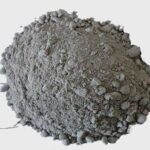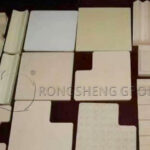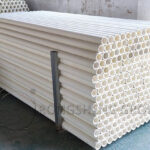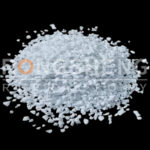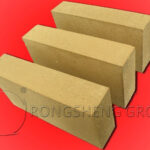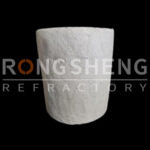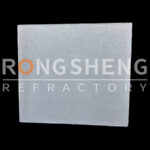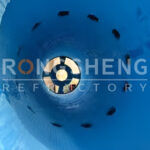Lightweight Refractory Castable Description
Lightweight refractory castable is made from lightweight refractory aggregate and powder, binder, and additives. Lightweight castable has low bulk density and thermal conductivity, so it is also called insulating refractory castable. By bulk density, lightweight castable can be divided into semi lightweight castable(1.0~1.8g/cm3), lightweight castable(0.4~1.0g/cm3) and ultra-lightweight castable(less than 0.4g/cm3). By max working temperature, lightweight castable can be divided into low-temperature lightweight castable (working temperature between 600~900℃), middle-temperature lightweight castable (working temperature between 900~1200℃), and high temperature lightweight refractory castables ( working temperature higher than 1200℃).
Low-Temperature Lightweight Castable
The raw materials are expansile vermiculate, expansile perlite, diatomite, low-temperature ceramsite and so on. The binders are ordinary silicate cement, aluminate cement and water glass. Different raw material content has different bulk density, take vermiculate castable for example, the mass ratio of expansile vermiculate and cement is (35~45) : (55~65). The higher expansile vermiculate content is, the lower bulk density is, as well as the strength and thermal conductivity.
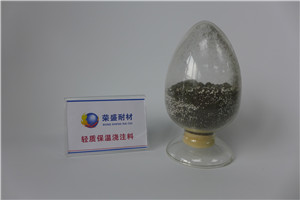
Expansile Perlite Castable Index
| Item | Index |
| Expansile perilite granularity | 1~8mm |
| Sintered bulk density(900℃) | 0.3~0.7g/cm3 |
| Compression strength Mpa (900℃) | 0.5~0.9 |
| Linear change rate % (900℃) | -0.6~1.2 |
| Thermal conductivity (700℃) W/(m.K) | 0.06~0.18 |
Middle Temperature Lightweight Castable
Middle temperature lightweight castable main materials are coal ash cenosphere, clay multi-pore clinker, lightweight clay brick material, shale ceramsite, clay ceramsite, aluminate fiber and so on. Cenoshpere lightweight castable has different bulk density, compression strength and thermal conductivity based on different cenosphere content.
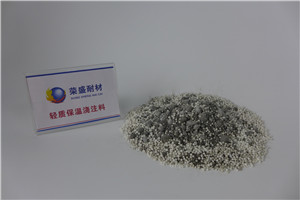
Lightweight Cenosphere castable index
| Item | B-1.0 | B-0.8 | B-0.6 |
| Bulk density g/cm3 | 0.9-1.0 | 0.7-0.8 | 0.5-0.6 |
| Compression strength Mpa (1000℃) | 4-6 | 3-4 | 2-3 |
| Linear change rate % (1000℃) | 0.5~-1 | -0.5~-1 | -1~-1.2 |
| Thermal conductivity (350℃) W/(m.K) | 0.3~0.4 | 0.25~0.30 | 0.2~0.25 |
High Temperature Lightweight Castable
High-temperature lightweight castable raw materials are high alumina, mullite, corundum, silica, and magnesia poly-porous clinker or lightweight used brick material, alumina, zirconia and mullite hollow balls, aluminate fiber, multi-crystalline phase mullite fiber, etc. Most often used high-temperature lightweight castables are high alumina lightweight castable, mullite lightweight castable, alumina hollow ball castable, zirconia hollow ball castable, high alumina fiber castable, and so on.
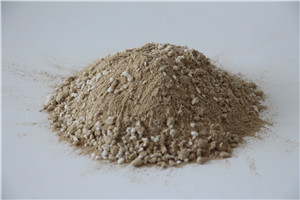
Mullite lightweight castable physiochemical index
| Item | MC-60 | MC-65 | MC-70 |
| Al2O3 % | 59~61 | 64~65 | 68~70 |
| Bulk density g/cm3 | 1.25~1.4 | 1.45~1.50 | 1.50~1.60 |
| Rupture strength Mpa (1350℃) | 1.5~2.5 | 2.5~3.5 | 3.0~4.5 |
| Linear change rate % (1350℃) | -0.2~-0.3 | 0~-0.2 | ±0.2 |
| Thermal conductivity (800℃) W/(m.K)-1 | 0.4~0.45 | 0.45~0.5 | 0.5~0.55 |
| Max working temperature ℃ | 1250 | 1350 | 1450 |
Lightweight Castable Applications
Lightweight castable has a wide range of applications in metallurgy, machinery, petrochemical industry, power plant, and building material industries. Lightweight castable is mainly as insulating layers of inner linings of industrial furnaces, thermal equipment, flues, and chimneys. Generally speaking, low temperature and middle-temperature lightweight castable is mainly used as an insulating lining, will not contact with fire directly, while the high temperature is mainly used as working linings, where don’t contact with molten material or solid media, especially the working linings of various kinds of heating furnaces and thermal treatment furnaces. For example, mullite lightweight castable can be directly used as the inner lining of atmosphere furnace with 1350℃ working temperature. Alumina hollow ball lightweight castable can be directly used as a working lining of high temperature (more than 1500℃) atmosphere furnaces.
